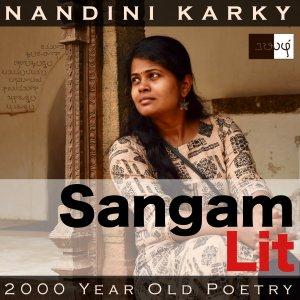Sangam Lit

Kalithogai 134 – The raft of a return
In this episode, we perceive the pain of a parted lady, as depicted in Sangam Literary work, Kalithogai 134, penned by Nallanthuvanaar. The verse is situated in the ‘Neythal’ or ‘Coastal Landscape’ and depicts the empathy, shown by the elements of the land.
மல்லரை மறம் சாய்த்த மலர்த் தண் தார் அகலத்தோன்,
ஒல்லாதார் உடன்று ஓட, உருத்து, உடன் எறிதலின்,
கொல் யானை அணி நுதல் அழுத்திய ஆழி போல்,
கல் சேர்பு ஞாயிறு கதிர் வாங்கி மறைதலின்,
இருங் கடல் ஒலித்து ஆங்கே இரவுக் காண்பது போல,
பெருங் கடல் ஓத நீர் வீங்குபு கரை சேர,
போஒய வண்டினால் புல்லென்ற துறையவாய்,
பாயல் கொள்பவை போல, கய மலர் வாய் கூம்ப,
ஒருநிலையே நடுக்குற்று, இவ் உலகெலாம் அச்சுற,
இரு நிலம் பெயர்ப்பு அன்ன, எவ்வம் கூர் மருள் மாலை
தவல் இல் நோய் செய்தவர்க் காணாமை நினைத்தலின்,
இகல் இடும் பனி தின, எவ்வத்துள் ஆழ்ந்து, ஆங்கே,
கவலை கொள் நெஞ்சினேன் கலுழ் தர, கடல் நோக்கி,
அவலம் மெய்க் கொண்டது போலும் அஃது எவன்கொலோ?
நடுங்கு நோய் செய்தவர் நல்காமை நினைத்தலின்,
கடும் பனி கைம்மிக, கையாற்றுள் ஆழ்ந்து, ஆங்கே,
நடுங்கு நோய் உழந்த என் நலன் அழிய, மணல் நோக்கி,
இடும்பை நோய்க்கு இகுவன போலும் அஃது எவன்கொலோ?
வையினர் நலன் உண்டார் வாராமை நினைத்தலின்,
கையறு நெஞ்சினேன் கலக்கத்துள் ஆழ்ந்து, ஆங்கே,
மையல் கொள் நெஞ்சொடு மயக்கத்தால், மரன் நோக்கி,
எவ்வத்தால் இயன்ற போல், இலை கூம்பல் எவன் கொலோ?
என ஆங்கு
கரை காணாப் பௌவத்து, கலம் சிதைந்து ஆழ்பவன்
திரை தரப் புணை பெற்று, தீது இன்றி உய்ந்தாங்கு,
விரைவனர் காதலர் புகுதர,
நிரை தொடி துயரம் நீங்கின்றால் விரைந்தே.
Here, the lady and the onlookers are rendering these thoughts! The words can be translated as follows:
“The One, wearing a moist flower garland, who destroyed the strength of enemy warriors, making his enemies scuttle away in fear, with rage, threw a discus that tore the fine forehead of a killer elephant. Akin to that, the sun settled in the mountains, retracting its rays, making the huge sea resound, sensing the arrival of night. As the flood of the huge seas swells and reaches the sands, forsaken by the parting bees, the shores look listless; As if about to attain sleep, the flowers in the pond close their buds. Akin to how the balance is disturbed when lands are torn apart at the end of time, making the world entire shiver in fear, arrives the suffering-filled evening of terror!
Thinking about how the one, who rendered this ceaseless disease, does not see me, as this cold season, which spews enmity eats me away, sinking in suffering, as my worried heart sheds tears, the sea looks at me and appears as if it has embraced my state of sorrow. Why is that so?
Thinking about how the one, who rendered this terrible disease, does not render his grace, as this intense cold season crosses its bounds, sinking in helplessness, as my beauty fades because of this terrible disease, the sands look at me and appear as if they are melting away, seeing my disease of despair. Why is that so?
Thinking about how the one, who relished my beauty and then stayed away, does not come to me, as I became one with a helpless heart, sinking in worry, as my heart that desires him becomes bewildered, the tree looks at me and appears as if it is moved by my suffering and closes its leaves. Why is that so?
And so, akin to how one, caught in a flood, unable to see the shores, thrashing after his ship is ruined, catches hold of a raft, brought by the waves, and is saved in the nick of time, as her lover, who came hurrying entered thither, the sorrow of the maiden, wearing rows of bangles, parted away in haste!”
Let’s delve into the details. The verse is situated in the context of the man’s parting away from the lady, prior to marriage, and here, the lady expresses her emotions followed by an observation of the onlookers. The lady begins by describing the arrival of the evening with a mythological reference of a god, making his enemy warriors scatter, and throwing a discus that lands on the forehead of a battle elephant, possibly referring to God Thirumaal. The act of the discus, vanishing into an elephant’s head, is placed in parallel to the setting of the sun in the mountain, which then makes the sea swell, the bees to leave the shores, and flowers to close their buds. The lady concludes this description by comparing the arrival of the evening to the end of the world. Then, she talks about how the seas, sands and trees seem to understand her pain of parting from the man in this terrible season of cold, and seem to shed tears on the shore, erode away because of the waves, and close their buds. She wonders at the compassion of these elements in the outer world and the apathy of her beloved.
The onlookers conclude this narration of the lady’s pain by describing the scene where a shipwrecked sailor, thrashing in the ocean, with no shore in sight, finally catches glimpse of a plank and holds on to it for dear life, and they compares this to the way the lady’s sorrow vanished, when the man hurried and returned to her. Yet again, the man is portrayed as the saviour of the lady, who is lost at sea in her very home, without him. Heartening to see how far have women have come from such a state of helplessness and dependancy, when we reflect on women sailors across ages, who have conquered the real storms of the seas, with their strength and intellect!






 Visit Podcast Website
Visit Podcast Website RSS Podcast Feed
RSS Podcast Feed Subscribe
Subscribe
 Add to MyCast
Add to MyCast